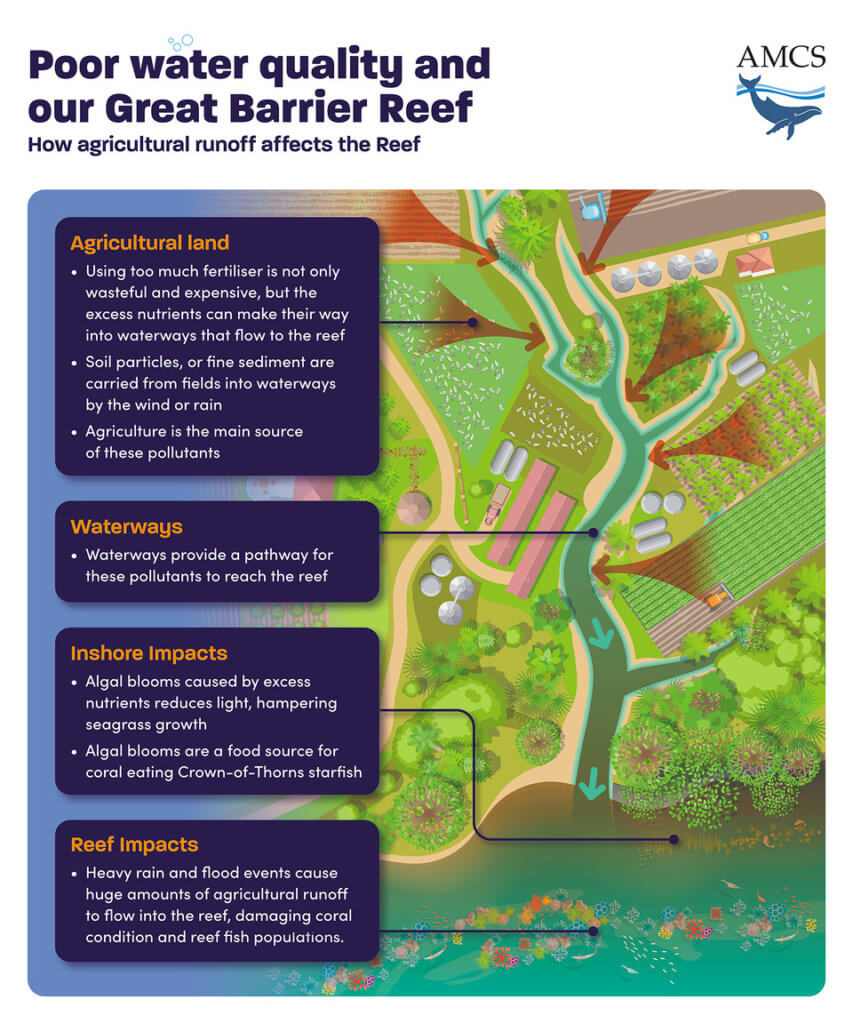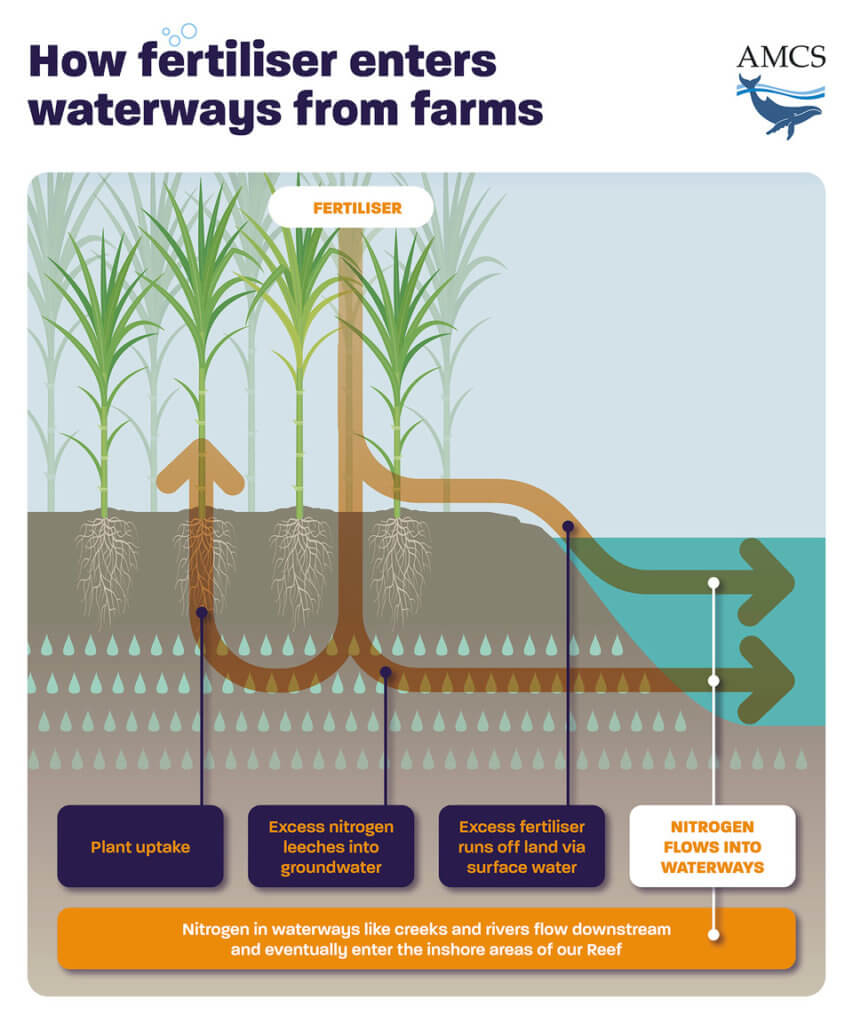On June 1, the latest round of Reef Protection Regulations came into force. The regulations, which began rolling out in 2019, are designed to improve the quality of the water that flows from farming and grazing properties in Queensland into our Great Barrier Reef (our Reef).
Water quality is a hugely important issue for our Reef, particularly the inshore areas and the marine life they support. Reef habitats including seagrass – essential for vulnerable and threatened species like dugongs and turtles – are increasingly threatened by the amounts of fertilisers (nitrogen) and sediment flowing from agricultural lands in the 35 adjacent catchments. A catchment is an area of land where water collects when it rains. Excess water on this land can then flow from high points to low points in the landscape, entering creeks, rivers, wetlands and then finally the ocean.
Scientific evidence has shown that improving water quality will help improve Reef resilience under a warming climate, improve ecosystem health and benefit local communities.
AMCS fought a long and hard campaign to get the regulations developed and passed and we are now working on having their implementation fully funded. The staged roll-out of the regulations have targeted those practices that pose the greatest risk for water quality. The regulations will finish rolling out in 2022.
Here our GBR Water Quality Manager Jaimi Webster explains why Reef water quality is so important, and dispels a few of the myths you may have seen in the media about the regulations and the impact of poor water quality on our Reef.

What is poor water quality and how does it affect the Reef?
Poor water quality is a major threat to inshore areas of our World Heritage listed Reef. Polluted water, containing sediment and chemical fertiliser, flowing from agricultural and urban/industrial lands in the catchments is discharged from rivers and can become trapped in the inshore areas of our Reef. Due to coastal currents and the influence of winds and tides, these areas are not flushed by the Coral Sea to the same extent as the outer reefs a hundred or more kilometres offshore. The inshore areas where the pollution tends to accumulate, are important habitat for turtles and dugongs and nurseries for juvenile fish of species like barramundi, red emperor and mangrove jack, which are targets for Queensland’s commercial and recreational fishers.
Decades of scientific studies have concluded consistently about the critical and urgent need to improve the quality of water running-off from agricultural lands. Sediment in the water reduces the sunlight available to seagrasses and inshore corals and can smother and kill them. The overuse of fertilisers can result in excess nutrients, which are an additional stress factor for many coral species and can result in harmful algal blooms. Algal blooms are a food source for juvenile crown-of-thorns starfish and also reduce the amount of light required for seagrasses to grow.
It’s important to emphasise that the inshore areas most impacted by poor water quality are also the places we like to visit and take tourists. Tourism is also an important industry for Reef coast communities and the water quality laws directly support their future.
Isn’t climate change the problem?
Our Reef needs to be strong in the face of rapidly warming oceans. While global warming remains the biggest threat to our Reef, polluted water from land-based activities is a long-standing and preventable problem, and entirely within our immediate control.
Our Reef has undergone three devastating bleaching events across five years – poor water quality hampers its recovery from these events. Our Reef has already lost 50% of its corals in just two decades (1997-2017) so we should be doing all we can to stop or ease this decline. Cleaning up the waters flowing into our Reef is one way, and doing all we can to lower our fossil fuel emissions is another.
Global warming-driven, extensive coral bleaching and extreme weather events coupled with poor water quality is a bit like our Reef being hit with the flu and never really being able to recover completely because it keeps catching a cold. For example, many of our seagrass meadows in inshore areas have never fully recovered from the 2011 flooding disasters because of continual exposure to poor water quality.
Do we really need the reef regulations?
Yes. Improving water quality by reducing the amount of nitrogen and sediment that flows from agricultural lands into inshore areas of our Reef is vital for the health of ecosystems like seagrass meadows and the iconic Reef species like dugongs and turtles that rely on them. There needs to be strong laws against all forms of pollution that impact our Reef.
For around two decades the Australian and Queensland governments have spent hundreds of millions of dollars trying to improve Reef water quality through a variety of voluntary schemes. Voluntary measures to stop water pollution have been insufficient to clean up the water flowing into our Reef, which is why the laws were introduced.
Improving water quality needs the support and dedication of all farmers and graziers in Queensland, not just a few here and there. Many farmers are already following best management practice and the regulations will bring the remainder into line. The 2019 Reef Report Card showed that on average only 12.7% of sugarcane growers had adopted best management practices so far, the target is 90% by 2025. The regulations have come into force since the last report card, so we expect a significant increase in the percentage of growers adopting best practice and a higher level of compliance by the next report card in 2022.

How will farmers and graziers be impacted by the regulations?
The regulations target land practices that pose the greatest risk for water quality, such as farmers who are applying excess fertiliser to their crops. The regulations require farmers and graziers to meet minimum practice agricultural standards and keep records of the activities being undertaken to meet those standards. Sugarcane growers are also required to develop nutrient budgets. The latest regulations require a permit for any new farming in the Reef catchments.
For those farmers and graziers already accredited against a recognised Best Management Practice (BMP) program from their industry body, complying with the regulations will not be much extra work, depending on their accreditation level. For those not BMP accredited, meeting the minimum practice agricultural standards will not only bring economic and environmental benefits to their farms, but also help other industries like tourism and commercial fishing, which rely on healthy Reef water.
Have regulations resulted in more work and less profit for farmers?
As many variables like rainfall and drought can impact the amount of sugarcane that is produced each season, it would be inaccurate to blame any lower production or profits on the regulations.
The regulations were designed and are being implemented in a way that tries to ensure productivity is not lost. We learnt recently that the 2021 sugarcane crop is on course to be bigger than 2020 and 2019, which is great news.
Some farmers and graziers may not like the regulations because they have to make changes to their practices. We would encourage them to embrace the economic and social opportunities that the regulations bring. Many farmers love to fish and good water quality is essential for the health of many inshore and reef fish species.
Reducing sediment loss from farms and grazing lands is important for water quality, but it will equally benefit farmers and graziers in the long term. When sediment is washed off the land and into waterways it carries with it important nutrients the land needs for vegetation, affecting soil health and productivity. Here is a great example of how some graziers can improve the quality of their land and the productivity of their cattle, whilst improving water quality to our Reef.
For those who are complying with the regulations, there are monetary initiatives like the Reef Credit Scheme, which provides a supplementary source of income for farmers that continue to make water quality improvements.
What are water quality targets and the Reef 2050 Plan?
Water quality targets have been set out in the Reef 2050 Water Quality Improvement Plan and are based on the quality of water that corals and seagrasses need to be healthy. These include targets for reducing the amount of sediment and nitrogen (fertiliser) entering the Reef’s waters by 2025, which have been identified as key issues for water quality, for example:
- 60% reduction in dissolved inorganic nitrogen
- 25% reduction in sediment
- 20% reduction in particulate nutrient loads, and
- 99% of aquatic species are protected from pesticides.
The water quality targets form part of the Reef 2050 Plan, which is the long term plan for managing the health of the Great Barrier Reef.
The 2015 Reef 2050 Plan, containing 151 actions, was developed by the Queensland and Australian governments in response to the UNESCO’s World Heritage Committee (WHC) considering listing the Reef ‘in danger’ in 2014. Addressing poor water quality was a key ask of the World Heritage Committee and they expressed concern in 2017 that progress was too slow in achieving the water quality targets.
The latest Reef water quality report card shows that progress is still lagging and we have a long way to go to achieve the water quality pollution load targets. As of 2019, we have made a 25.5% reduction in dissolved inorganic nitrogen with the target set at 60%, we have a 34.5% reduction to achieve by 2025. With that in mind, these regulations are crucial for the future of our Reef, the wonderful wildlife it is home to, and the thousands of jobs it supports in Queensland.
The regulations will do a lot of the heavy lifting required to reach the water quality targets, however more improvements will be needed even at full compliance with the regulations. Progress towards the targets will also need to include; supporting industries and communities to implement innovative initiatives and activities that will take them beyond the regulations; restoring catchments through repairing vegetation along waterways and wetlands; and reducing urban and industrial pollution loads in the more urbanised catchments.
Where are the regulations up to now?
As of 1 June 2021, new farming activities will require an environmental authority (permit). To be approved for this mandatory permit, eligible farmers will be required to design and implement erosion and sediment control measures. These measures need to minimise any soil loss and water run-off to reduce sediment and nutrient pollution in Reef waters.
This latest tranche of regulations allows for the expansion of agriculture in the Reef catchments while ensuring new activities don’t result in further degradation of Reef water quality.
The new regulations apply to farmers in each of the six Reef catchment regions- from north to south – Cape York, Wet Tropics, Burdekin, Mackay Whitsunday, Fitzroy and Burnett Mary.
The Queensland Government has produced a checklist to help farmers and graziers understand when a permit is required, and are currently holding information sessions in regional Queensland to provide information and answer questions on the new regulations.